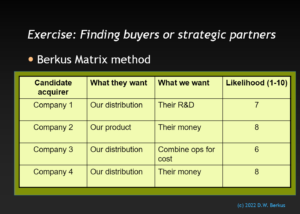So, what’s the difference?
First, thanks to longtime reader and friend, Harley Kaufman, for the thought and title for this insight. He stated, “Too often it seemed our internal staff was more focused on getting the ‘work’ (daily tasks) done and not enough on the ‘job’ (supporting subordinates with resources and encouragement.)”
Wait. Had I been guilty?
Of course, this comment made me think of the many times I had been guilty of this more than occasional heads-down office work over the years of management and assume that most of you who have supervised others have fallen into the same trap. I recall one of my CEO’s when I was his chairman, stating, “If you are not serving our customers, then you should be supporting those who do”. Is that statement a bit of a stretch for those in the lowest levels of office work, such as posting accounts payable invoices? Maybe not.
How do you frame menial desk jobs as “customer support?”
[Email readers, continue here…] Even the most menial of jobs fit into the grand scheme of customer support. Some accounts payable invoices come from suppliers providing the company resources to serve the customer. Moreover, most managers of all groups work to make the company better at servicing the sales staff, the customer support group, or the customer directly. So, it would be easier to see why you’d want to get behind the rallying cry from that CEO who focused his staff upon the customer – and the company’s mission – which surely incorporated the customer in the first sentence.
Shout it out!
Harley went further by hanging a banner on the wall of the office with the headline to this insight in bold, large type. He made it clear that this wasn’t just another sentence in a mission statement to be read by a few and immediately forgotten.
Let’s take this thought one step further.
If you manage even one other person, are you guilty of focusing upon your deskwork a bit too often when you could have been coaching, supporting, and asking generating questions of your subordinate(s)?
Generative questions?
 “What problems are you working with where you could use resources or help?” “Where is your bottleneck, preventing you from doing your job most efficiently?” “How can I help you succeed today and in the longer run?” “What if you had more resources, how would you use them to better serve our customers?” “What do you see happening that we could do better?”
“What problems are you working with where you could use resources or help?” “Where is your bottleneck, preventing you from doing your job most efficiently?” “How can I help you succeed today and in the longer run?” “What if you had more resources, how would you use them to better serve our customers?” “What do you see happening that we could do better?”
Generative questions such as these make people think and respond in ways they might not have considered. That’s much better than “How’re you doing today?” to which most people would respond, “Fine” and which would usually end the conversation without generating any positive or negative response or thought.
So, with these thoughts and questions aimed at you, are you a manager who uses generative questions to elicit thoughtful conversations? If not, consider how you can better support your customers directly or by supporting your direct reports.
Be a better manager of people. Don’t let your work interfere with your job.


 Then make a rule that exceptions for commission calculations can be made only for contracts above some large trigger amount. Codify that the salesperson cannot discount lower than some percentage of the stated prices, usually ten percent, without management approval – and possible commission percentage impact.
Then make a rule that exceptions for commission calculations can be made only for contracts above some large trigger amount. Codify that the salesperson cannot discount lower than some percentage of the stated prices, usually ten percent, without management approval – and possible commission percentage impact. to think so, or we wouldn’t do it in the first place.
to think so, or we wouldn’t do it in the first place. Will the requested outcome advance any of your goals – or just provide an increment of satisfaction? Will the output be used in a meaningful way? Or will this just be another reason for that cynical associate or employee to label you with that term?
Will the requested outcome advance any of your goals – or just provide an increment of satisfaction? Will the output be used in a meaningful way? Or will this just be another reason for that cynical associate or employee to label you with that term?

 repeat them? By being a visible example. A friend and fellow CEO states that he publishes each of his mistakes in his company internal blog along with the lesson he learned. “If the CEO can do this, he gives permission for anyone to confess as well,” he states.
repeat them? By being a visible example. A friend and fellow CEO states that he publishes each of his mistakes in his company internal blog along with the lesson he learned. “If the CEO can do this, he gives permission for anyone to confess as well,” he states. learning opportunity is lost or someone hides actions from management? And what does it say about your corporate culture and your individual management style? Even if you condone the overreaction of others in management, aren’t you then guilty of reinforcing such a culture of punishment over learning?
learning opportunity is lost or someone hides actions from management? And what does it say about your corporate culture and your individual management style? Even if you condone the overreaction of others in management, aren’t you then guilty of reinforcing such a culture of punishment over learning? were the only such facility on the West coast to provide and control the entire process from studio, through finished vinyl record pressings in the same building, therefore able to promise quality control others could only dream about.
were the only such facility on the West coast to provide and control the entire process from studio, through finished vinyl record pressings in the same building, therefore able to promise quality control others could only dream about. It had taken years to learn that empathy comes from experience, not just perceived understanding. And that there is such a thing as a business leader showing empathy while making good strategic decisions. I learned that employees appreciate knowing that their executives have experienced and can understand their world. I learned that tough decisions, such as denial of a request, are better received when all affected know that there was a deeper understanding of the issue and reasons for the response.
It had taken years to learn that empathy comes from experience, not just perceived understanding. And that there is such a thing as a business leader showing empathy while making good strategic decisions. I learned that employees appreciate knowing that their executives have experienced and can understand their world. I learned that tough decisions, such as denial of a request, are better received when all affected know that there was a deeper understanding of the issue and reasons for the response. employees and customers. You worry that the person leaving will begin to unload all the pent–up garbage from the past, perhaps damaging the company and causing customer defections and even employee unrest.
employees and customers. You worry that the person leaving will begin to unload all the pent–up garbage from the past, perhaps damaging the company and causing customer defections and even employee unrest. Even today, many years later, former employees who departed during my tenure, find me at trade shows and other industry events, telling me that their experience with us was the best they’d ever had with any employer.
Even today, many years later, former employees who departed during my tenure, find me at trade shows and other industry events, telling me that their experience with us was the best they’d ever had with any employer. matrix shown on this page. It will help you to focus upon the most likely candidates and save lots of time. Here are the steps to take.
matrix shown on this page. It will help you to focus upon the most likely candidates and save lots of time. Here are the steps to take. resurrect the concept in his book published in 1970. Not quite as bold as inverting the management triangle, the concept of servant leadership requires that a business manager focus upon his or her people’s highest priority needs first.
resurrect the concept in his book published in 1970. Not quite as bold as inverting the management triangle, the concept of servant leadership requires that a business manager focus upon his or her people’s highest priority needs first.  But the perception of that leader being soft and lacking in strong leadership traits is the sure result of using this method as the leading style for a CEO. It is fine as a secondary style used in tactical decision–making, when strategic issues are not the focus, and where threats to corporate health or resources are not evident.
But the perception of that leader being soft and lacking in strong leadership traits is the sure result of using this method as the leading style for a CEO. It is fine as a secondary style used in tactical decision–making, when strategic issues are not the focus, and where threats to corporate health or resources are not evident. and checking in with managers and employees of the various departments, especially the call center. He tried to feel the pulse of the company by the intensity of motion, the metrics of backlog, and the stated problems brought to him as he asked
and checking in with managers and employees of the various departments, especially the call center. He tried to feel the pulse of the company by the intensity of motion, the metrics of backlog, and the stated problems brought to him as he asked A good manager can feel the mood and the level of business activity, but not easily from behind a desk or on the other end of a phone or Zoom call.
A good manager can feel the mood and the level of business activity, but not easily from behind a desk or on the other end of a phone or Zoom call.